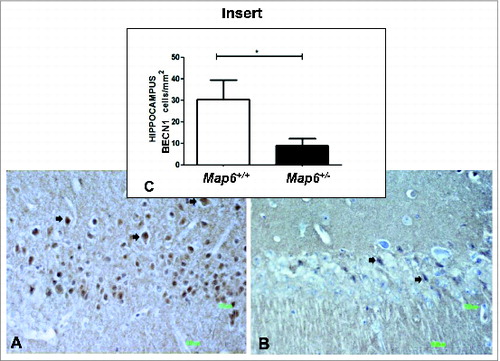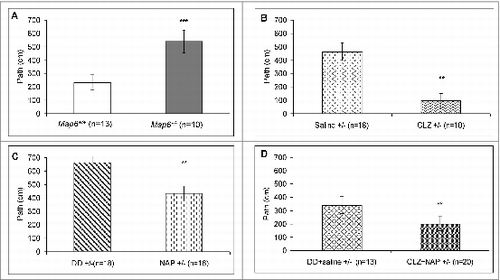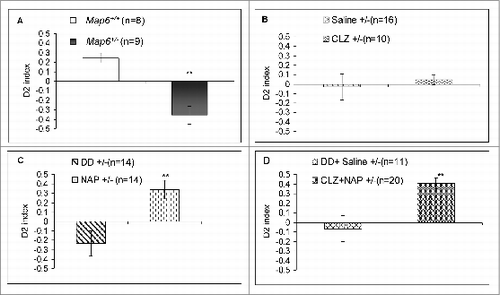Figures & data
Figure 1. Map6+/− mice, like human schizophrenia subjects, show hippocampal Becn1 deficiency. Experiments are detailed in Materials and Methods. Panels (A–C) compare naïve Map6+/+ to naïve Map6+/− mice. A representative stained section is shown in (A) for Map6+/+ and a representative stained section is shown in (B) for Map6+/− mice (arrows denote stained cells). Panel (C, insert) shows the comparison between the stained cell number/mm2 in (A) vs. (B), showing approximately 3-fold reduction in Map6+/− mice as compared to controls (Student t test, *P < 0.05).

Figure 2. Becn1 expression-deficiency in Map6+/− mice is ameliorated by NAP + CLZ combination treatment. Quantitative real-time PCR was performed for Adnp (white bars), Adnp2 (gray bars) and Becn1 (black bars). Results are depicted in graphs of percentage of expression of the naïve Map6+/− mice. Each transcript was compared to itself in Map6+/− mice vs. Map6+/+ mice (A) or the comparative treatment with the relevant vehicle, all in the Map6+/− mice (Saline vs. CLZ+/- (i.e. saline-treated Map6+/− mice or CLZ treated Map6+/− respectively), B; DD vs. NAP+/- (i.e., DD-treated Map6+/− mice or NAP treated Map6+/− respectively), C and DD+Saline vs. NAP+CLZ+/-, D) using the Student t test. Panel A compares Map6+/− mice to Map6+/+ mice. A significant ∼40% decrease was observed for all tested genes in the Map6+/- mice (***P < 0.001). Panel (B) shows no effect for CLZ treatment when compared to saline injection, while panel (C) shows a significant effect of NAP on Becn1 expression and Adnp2 expression (with NAP normalizing Becn1 expression) in comparison to vehicle only, (*P < 0.05). Panel (D) shows that the combination of CLZ+NAP normalized Becn1 expression (*P < 0.05).

Figure 3. Map6+/− mice suffer from hyperactivity in the open field which is normalized by NAP + CLZ combination treatment. The results are shown as the mean of the path in cm per animal in the 3-min time period. Map6+/+ (Sv129) controls exhibited a significant difference from their and Map6+/− (heterozygous) littermates (A,***P < 0.001, Student t test). Panel (B) compares CLZ and saline (vehicle)-treated Map6+/− mice. CLZ significantly reduced hyperactivity in the Map6+/- mice (***P < 0.001, Student t test). Panel (C) compares intranasal NAP and intranasal DD (vehicle)-treated Map6+/− mice. NAP significantly reduced hyperactivity in the Map6+/− mice (**P < 0.01, Student t test). Panel (D) compares combination treatment of NAP and CLZ to the appropriate vehicle control showing significant protection against hyperactivity (**P < 0.01, Student t test). In (D), treatment with DD+saline significantly decreased activity, possibility associated with the repeated handling in comparison to the Map6+/− mice (from 3A, P < 0.001, Student t test).

Figure 4. The Map6+/− mice schizophrenic-like preference to familiar rather than novel objects is normalized by NAP + CLZ combination treatment. Map6+/- mice showed significant deficits in recognizing the novel object and seemed to significantly prefer the familiar object in comparison to control Map6+/+ mice (A,**P < 0.01, Student t test). CLZ treatment did not significantly improve object recognition/discrimination in the Map6+/- mice (B) NAP treatment significantly improved object recognition/discrimination in the Map6+/- mice (**P < 0.01, Student t test) to the control Map6+/+ level (C) NAP+CLZ treatment significantly improved object recognition and discrimination in the Map6+/- mice (**P < 0.01, Student t test) to the control Map6+/+ mouse level (D). Although in (B), saline treatment appears to increase discrimination in comparison to the Map6+/- mice from (A), statistical analysis showed a P value of 0.073 (Student t test).

Figure 5. NAP protects against CLZ-associated cell death. In a neuronal cell culture model (human SH-SY5Y neuroblastoma) CLZ treatment resulted in approximately 40% decreased viability (A, CLZ vs. B, control, no CLZ). NAP treatment at 10−15M to 10−13M completely protected against CLZ-related reduction in viability. (NAP+CLZ vs. CLZ, one-way ANOVA, F(3) = 103.618, P < 0.001. The Fisher Least Significant Difference (LSD) post-hoc test revealed protection by NAP concentration of 10−15M - 10−13M: ***P < 0.001), (A). In the same neuronal cell model, without the addition of CLZ, at a wide concentration range (10−16M to 10−11M), NAP did not affect cell viability or cell division (P > 0.05), (B). However, the control group in (B) shows an ‘unacceptably large variance’, thus preventing the correct assessment of NAP effect. Experiments were repeated 3 times; one representative experiment is shown (n = 5 to 10/group/experiment).

